|
|
||||
| home | ||||
| GLASERWORKS. The Cincinnati Zoo Kids' Shop |
||||
| [in
italiano] |
"There are no right angles found in Nature", is an aphorism of untraceable origins. It must have sounded memorably significant coming from Buckminster Fuller. Coming from the authoritative director of the Cincinnati Zoo and Botanical Garden it had the meaning of a direct instruction regarding the formal parameters of the project we were discussing: the Zoo's Kids' Gift Shop. North-East view. Traditionally architecture at the zoo was cast in a supporting role, playing off aboriginal vernacular against a heavy mass of vegetation. |
[29oct2001] | ||
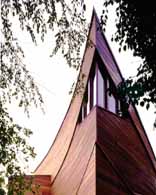 Rear (North-West) view.  Detail of North-West wall. 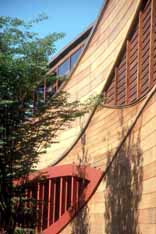 Detail of East wall. |
From the very beginning of the project, the adequate solution of our design problem lied in our ability to present architecture as an organic endeavor which does not contradict the rules of a natural environment. The irony was that a zoo, with its carefully staged exhibit layouts, its scientifically rigorous daily, seasonal and yearly routine is more analogous to an industrial enterprise than a pristine habitat. It is a western statement about nature. It is as far from a natural environment as it gets.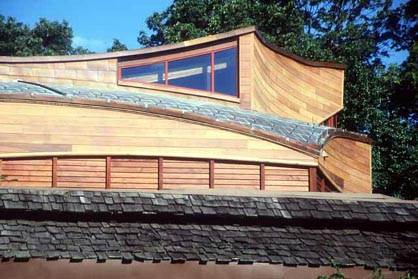 Old and new zoo architecture (roof of train station in foreground). The brief described a simple but fairly convoluted program due to the immediate adjacency of its heterogeneous set of elements. The retail and storage areas were the anchor around which gravitated a concession stand and exterior restrooms with their supporting infrastructure. Borrowing a Disney ploy, the building would also house a crossroad: it was to accommodate the entrance to and contain the exit from the Children's Zoo, a discreet area within the zoo compound. A ticket booth at its entrance was incorporated into the volume. A busy, fractured and confusing waiting area for the train station had formed in front of the site, which the Kids' Shop predecessor did a poor job addressing. Another of the old shop's shortcomings was the lack of openness due to its traditional interpretation of the sea-ranch type. The need to attract passers by was on top of our clients' priority list. |
|||
| We arrived at the morphological domain we sought after a series of studies in a variety of media. The fluid play of two interacting volumes, which originated in clay, was controlled by quadratic surfaces in a subsequent computer model. The parti had a biological connotation. The instinctive response of animals to stimuli, their dynamic relationship to their exteriority captured in a freeze-frame was the paradigm we adopted. We researched and abstracted animal movement while trying not to mimic any particular biology. The snap shot convulsion reacted to the site intensities by curving to form the back of an oval piazza, which would reformulate the train station waiting and concessions area. In the relationship of the two reversely bent bodies we found the formal set of rules governing the formal parameters of the opositions transparency-opacity and smooth-rough. |
 Morphogenesis. |
|||
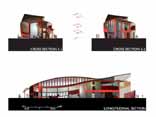 Cross and longitudinal sections.  First and second floor plans. |
Capturing the subtlety of corporeal dynamic involved application of higher level, non-linear geometry. That necessitated that its translation into construction technologies be immediate, very accurate, and verifiable. The computer model created in the FormZ software package allowed us unprecedented control over the geometry, demystified the detailing process, and made interactions with numerous consultants direct and unequivocal. It gave us the algorithm for fabricating the more than 150 different glu-lam components of the structural frame without going overboard our precariously knit together budget. The selection of wood for both the structure and exterior cladding maintained the consistency of our scenario. The biological metaphor, which emerged in the clay studies, was enhanced by layering the skin to expose the internal stratification of the bodies. The smooth, light, outer epidermis "peels off" to consequently reveal a rougher, darker substratum; the layer below it shows traces of inner articulation; and finally, tissues thin to allow a peek into the inner organs: glass. We used different profiles of cedar siding and corresponding semi-translucent wood stain to enhance the legibility of intention. |
|||
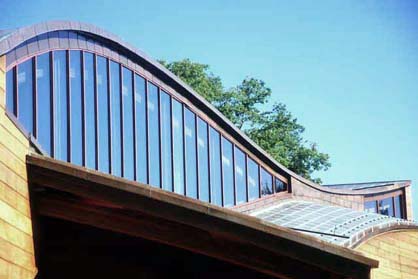 Clerestory windows. The thin, smooth, scaly copper membrane of the roof has already started changing into its patinated permanent state. It participates in the composition both as the vertical boundary of the composition and as its principal morphogenetic factor. Repetitions and intersections of the roof surfaces of the 2 bodies created the geometric variety which yielded the shape and placement of the formal and structural features of the building. The interior of the retail part with its undulating, reaching 26 feet height ceiling, supported by the exposed glu-lam ribs, creates the sensation of a beast's belly. Glazing in the second floor wall allows carefully planned deep views following the ceiling curvature while obscuring the jumble of the storage area. In an atypical gesture for the retail world, there is a lot of natural light both from the clerestory and from the windows along the perimeter. The latter also address the different settings in front and at the back of the building. 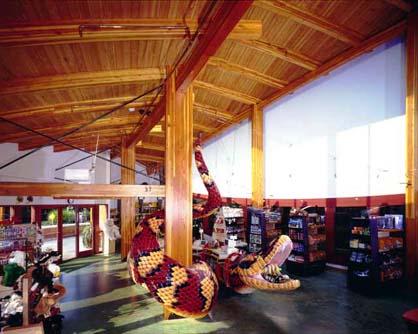 Interior view with cash-wrap. |
glaserworks.
The firm was founded in 1958 as Glaser and Meyers, changed to Glaser Associates in 1992, to glaserworks in 2001. It has been continually building a metropolitan architectural and urban design practice in Cincinnati, OH. We have maintained a size of 25-30 highly motivated individuals with a taste for challenging and non-traditional design assignments. We have been involved in a range of public projects as diverse as the recently completed Bengals stadium (with NBBJ Sports and Entertainment), and the masterplan, and over the last two decades several buildings at the Cincinnati Zoo. We designed several of Cincinnati's award winning Riverfront Parks, the city's Playhouse in the Park and Art Museum, and are engaged in various projects at The University of Cincinnati. |
|||
 |
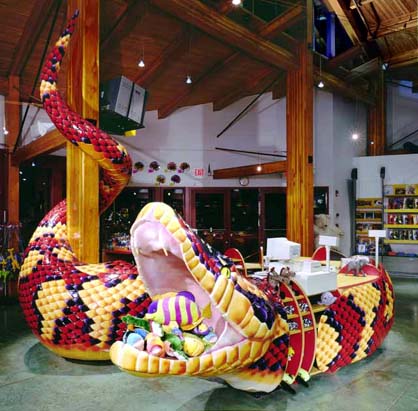 Cash-wrap at night. The cash-wrap is a folly with a purpose. A snakelike creature descending from the rafters. (It is made of interlocking ľ" laminated plywood shapes and four sculpted fiberglass parts.) It is the Kids' Shop, after all. Raffi Tomassian tomassian@glaserworks.com |
|||
|
GLASERWORKS. The Cincinnati Zoo Kids' Shop |
||||
 Site plan. |
Design team Art Hupp: Principal in Charge Paul Duffy: Project Manager David Schmidt: Project Architect Raffi Tomassian: Designer Project credits Structural Engineer: Steven Schaefer Associates MEP Engineers: CDS Associates General Contractor: Turner Construction Co., Special Projects Division Glu-lam fabricator: Timber Systems, Toronto, Canada Photography J. Miles Wolfă |
|||
|
>
GLASERWORKS > ARCHITETTURE |
||||
per partecipare alla rubrica architetture laboratorio
|
||||